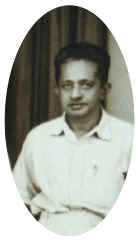Dr. Patrick John de Fonseka contributed immensely to the treatment and containment of Leprosy in the 60’s, when Leprosy sufferers were ostracised by society. He worked hard to remove the stigma attached to the disease. Dr Patrick died on 20th June 1999
 It was sad to learn that Dr. P. J. de Fonseka (Patrick) was laid to his eternal rest on 20th June 1999. Dr. Fonseka was a devout Catholic who choose to work in the field of leprosy as his mission in life. During his over 23 years of service in leprosy he was Medical Officer, Leprosy Hospital Hendala, became Its Medical Superintendent subsequently, and finally Superintendent of the Anti-Leprosy Campaign in 1954. He retired in 1971.Within the hospital, knowing that they were ostracised by society, the patients were very demanding and often vented their frustrations on him; but being the simple and humble soul that he was, he always gave them a patient hearing and sought out ways to redress their grievances. Leprosy was a low priority subject for the Head Office and often received step-motherly treatment.
It was sad to learn that Dr. P. J. de Fonseka (Patrick) was laid to his eternal rest on 20th June 1999. Dr. Fonseka was a devout Catholic who choose to work in the field of leprosy as his mission in life. During his over 23 years of service in leprosy he was Medical Officer, Leprosy Hospital Hendala, became Its Medical Superintendent subsequently, and finally Superintendent of the Anti-Leprosy Campaign in 1954. He retired in 1971.Within the hospital, knowing that they were ostracised by society, the patients were very demanding and often vented their frustrations on him; but being the simple and humble soul that he was, he always gave them a patient hearing and sought out ways to redress their grievances. Leprosy was a low priority subject for the Head Office and often received step-motherly treatment.
He was equally concerned about his staff and genuinely interested in their welfare and personal problems, and kind words and deeds were second nature to him. The departure of the Roman Catholic nuns in 1964 was a great blow to the patients but they left behind a sufficiently motivated staff of about five nurses and a fair number of female and male attendants and labourers who were able to carry on the good work with Dr. Fonseka and dedicated workers like Dr G. S. Arudpragasam, Dr. C. R. K. Tillekeratne and two Asst. Medical Practitioners and two M.L.TT.
Dr. Fonseka was also instrumental in getting the services of an Occupational Therapist, Physiotherapist and the help of the orthopedic Clinic to turn out shoes and other appliances for the disabled patients.
He worked hard to remove the stigma attached to the disease. He introduced the Leprosy Allowance for non-infective patients with the assistance of the Department of Social services to persuade fit patient to leave hospital and manage their lives in their home surroundings.
The Rehabilitation Colony at Urugasmanhandiya was set up in 1960 with the same aim and flourished for a few years, but subsequently due to lack of suitable patients and local protests was closed but not before achieving its aims. He got the Field Staff increased front 6 to 15 to treat and follow up known cases and contacts and to conduct surveys to detect new cases.
It was mainly due to his educative efforts through numerous circulars and personal contact with medical institutions and medical and para-medical staff that he was able to reduce the fear and stigma attached to the disease, that resulted in local hospitals and dispensaries treating leprosy patients for minor ailments and ulcers instead of rejecting them or referring them to leprosy hospitals in Hendala or Mantivu. Indeed obtaining Room 21 of the OPD General Hospital, Colombo to house the main diagnostic and Field Control Centre was a singular achievement of his, as at that time it was unthinkable that a Leprosy Clinic could be housed in a general out – patients department.
Office bearers and well – wishers of the Leprosy Association of Sri Lanka were responsible for renovating this Clinic in about 1970 to its present condition. It is heartening to learn that organisations like Naotis, Surol and Emmause of Switzerland are continuing the good work under the aegis of the Anti Leprosy Campaign to help patients and also to bring the disease under control if not to eradicate.
To Mrs. Fonseka and members of the family we tender our deepest sympathies.
May God bless his soul.
B. M. H. Sally
Photograph courtesy Siraj Perera (1961).